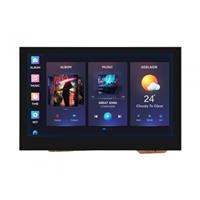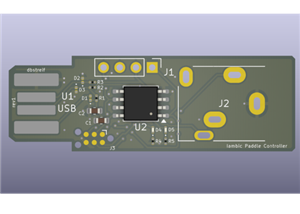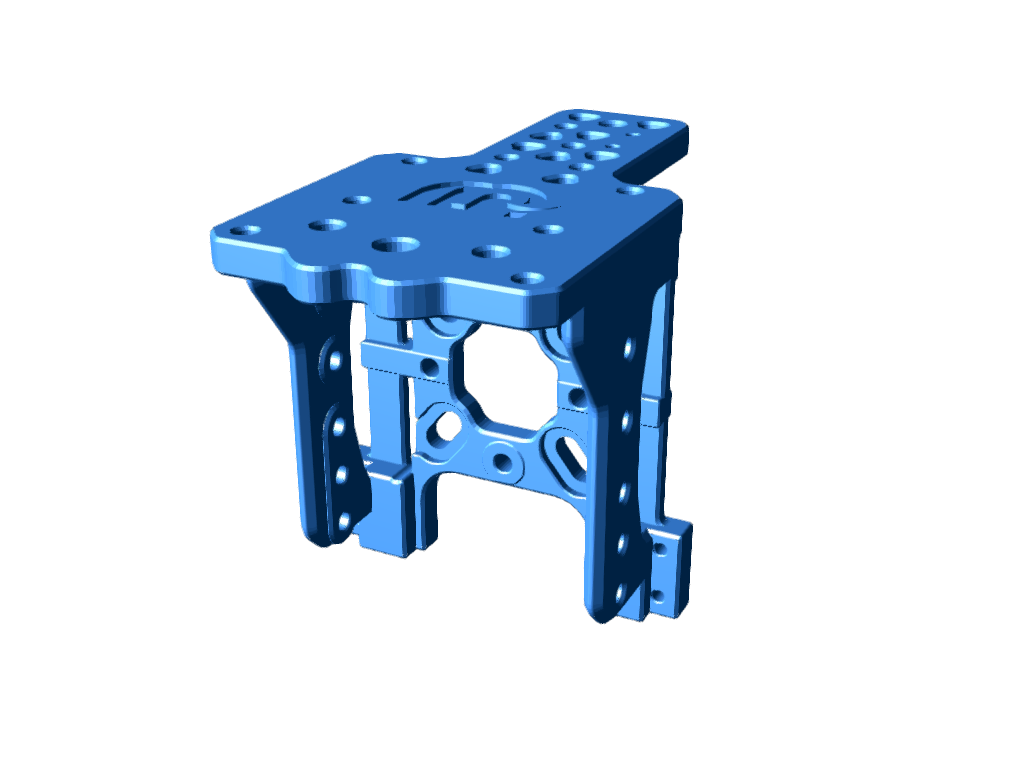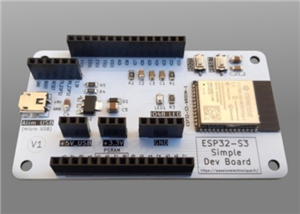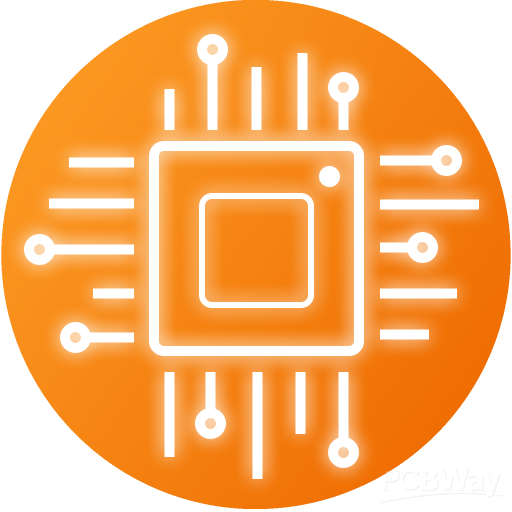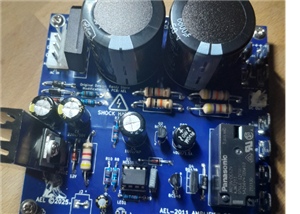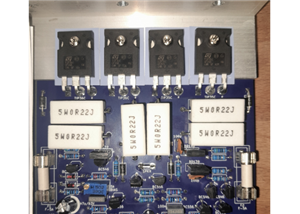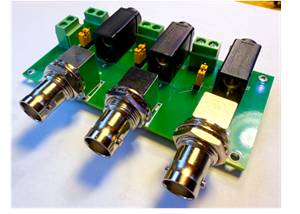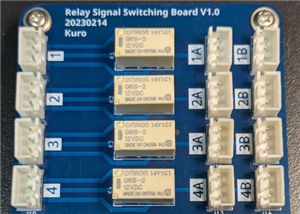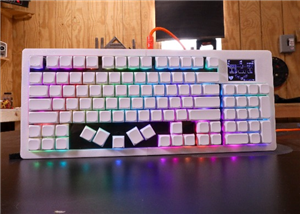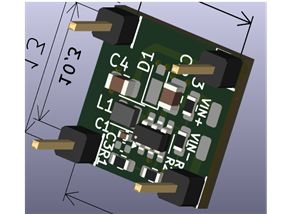|
|
Tesla coil Driver Board |
x 1 | |
|
|
Primary coil |
x 1 | |
|
|
Secondary coil |
x 1 | |
|
|
12V 5A Power Supply |
x 1 |

|
Soldering Iron Kit |
Exploring the Tesla Coil Driver Board, Full Review & Test Results
Some time ago I presented you a video in which I analyzed a super cheap Tesla Coil driver that cost less than $20. This time I will also present you a relatively cheap other type of driver that costs about $50, but is complete and contains a half-bridge circuit with two power mosfets with appropriate heat sinks, as well as a full-wave rectifier.

In short, in this case I only need the coils, the primary and the secondary to assemble a functional Tesla Coil. In this particular example, I'm using a factory-made primary and secondary coil with top load, so it only took me a few minutes to get the device up and running.
First, let's examine the board itself and the elements on it. It is immediately clear that it is quality made on a double-sided laminated PCB. It has the low-voltage part, which is separated from the high-voltage part by white border.

Unlike the previously mentioned module, in this case SMD components are used, which reduces the required board space and cost, and also simplifies the manufacturing process. Low voltage part is powered by an external 12V DC source. Switch selects the operating mode between interrupted or audio modulated. Componets used in interrupter and audio modulator part are two 555 timer ICs, LM393 comparator, and a 74HC14. With the two potentiometers, independent pulse width and frequency can be adjusted in interrupter mode.

This project is sponsored by PCBWay. They has all the services you need to create your project at the best price, whether is a scool project, or complex professional project. On PCBWay you can share your experiences, or get inspiration for your next project. They also provide completed Surface mount SMT PCB assemblY service at a best price, and ISO9001 quality control. Visit pcbway.com for more services.

In music mode only the pulse width can be adjusted, because the frequency is controlled by the music. The small magnetic loop feedbacks the ground wire of the secondary coil. Depending on the direction of the wire, the position of this miniature switch changes. The other part consists of a UCC 37324 dual channel gate driver chip, followed by two complementary MOSFETs of the AO4606 type. In this way, overloading of the gate driver chip is avoided. There is a gate driver transformer to which are connected two power MOSFETs of the type W20NM60, mounted on relatively massive heat sinks, which in terms of characteristics correspond to the well-known IRFP460. The high-voltage section consists of a fuse, a Gretz bridge, and a filter capacitor with a large capacity of 220 microfarads, providing power for the half-bridge MOSFET configuration. The primary winding of the Tesla coil is connected to green terminal, and on other terminal a voltage of maximum 220V. Before I start testing, let me warn you that this experiment will use high voltages that are dangerous to life and health, so I do not recommend repeating it at home unless you have extensive prior knowledge in this area. According to the manufacturer's recommendations, the inductance of the primary coil is recommended to be at least about 7uH, and the resonant frequency of the secondary to range between 200 and 800 Kilohertz.

Specifically in this case, the inductance of this primary coil is 7µH, which is the minimum allowed value, in order to obtain the best possible results. The secondary has a resonant frequency of about 240KHz (about 1200 turns on 7cm diameter body) calculated together with the top load. Now let's see how this device works in real conditions. First we connect the primary coil to the appropriate place, then we pass the beginning of the secondary through this magnetic loop, then to ground. Then we connect a 12V DC source to the appropriate connector, and finally a mains power supply which is good to connect via a variac if you have one. We set the switch to interrupter mode. Now gradually increase the voltage to approximately 50 volts. I bring the CFL bulb closer to the secondary, and if it does not light up, we need to switch the micro switch to the other position.

The lamp should be activated and this is a sign that everything is well connected, and I can start increasing the voltage.

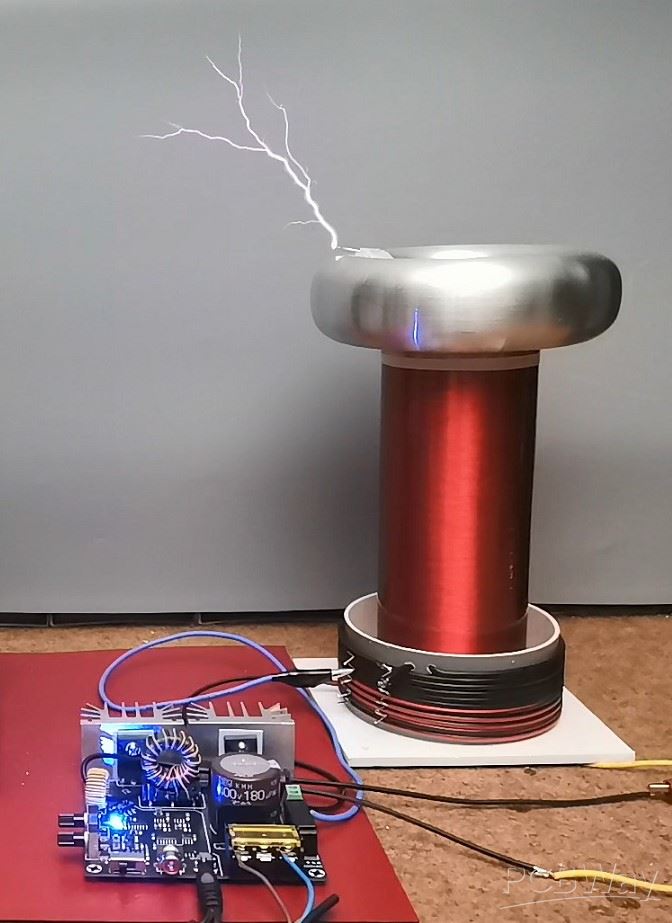

As you can see, the spark is wild with a variable shape, similar to a spark gap Tesla coil, which is a result of the low resonant frequency of the secondary. The length of the spark is slightly more than 12cm, which corresponds to the description of the manufacturer of this driver. It is surprising that the temperature of the power MOSFETs is very low even after long-term operation of the device, which is due to the short duration of the pulse generated by the interrupter.

It also works quite solidly in music mode where square wave music playback is supported

And finally, a short conclusion. This is a relatively cheap complete Tesla coil driver, so we only need a primary and secondary coil, and in a few minutes we can make a good, powerful, functional Tesla coil, suitable for long-term continuous operation.
SAFETY NOTE: Please do not attempt to recreate the experiments shown on this video unless you are familiar with High Voltage Safety Techniques! Direct Current even above 60V maybe lethal, even when the AC supply voltage has been disconnected due to the stored energy in the capacitors.
Exploring the Tesla Coil Driver Board, Full Review & Test Results
- Comments(0)
- Likes(1)
-
 Engineer
Aug 10,2025
Engineer
Aug 10,2025
- 0 USER VOTES
- YOUR VOTE 0.00 0.00
- 1
- 2
- 3
- 4
- 5
- 6
- 7
- 8
- 9
- 10
- 1
- 2
- 3
- 4
- 5
- 6
- 7
- 8
- 9
- 10
- 1
- 2
- 3
- 4
- 5
- 6
- 7
- 8
- 9
- 10
- 1
- 2
- 3
- 4
- 5
- 6
- 7
- 8
- 9
- 10
 More by Mirko Pavleski
More by Mirko Pavleski
-
 Arduino 3D Printed self Balancing Cube
Self-balancing devices are electronic devices that use sensors and motors to keep themselves balanc...
Arduino 3D Printed self Balancing Cube
Self-balancing devices are electronic devices that use sensors and motors to keep themselves balanc...
-
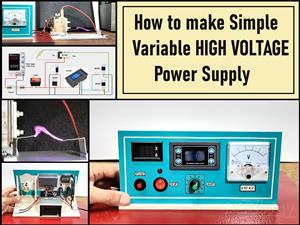 How to make simple Variable HIGH VOLTAGE Power Supply
High Voltage Power Supply is usually understood as a device that is capable of generating a voltage...
How to make simple Variable HIGH VOLTAGE Power Supply
High Voltage Power Supply is usually understood as a device that is capable of generating a voltage...
-
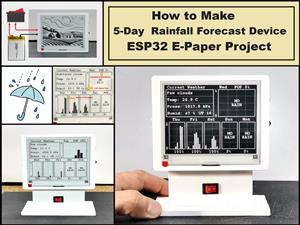 DIY 5-Day Rainfall Forecast Device - ESP32 E-Paper Project
In several of my previous projects I have presented ways to make weather stations, but this time I ...
DIY 5-Day Rainfall Forecast Device - ESP32 E-Paper Project
In several of my previous projects I have presented ways to make weather stations, but this time I ...
-
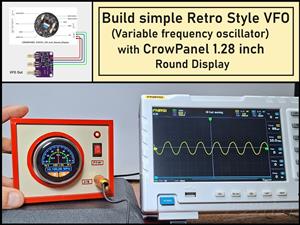 Build simple Retro Style VFO (Variable frequency oscillator) with Crowoanel 1.28 inch Round Display
Today I received a shipment with a Small round LCD display from Elecrow. The device is packed in tw...
Build simple Retro Style VFO (Variable frequency oscillator) with Crowoanel 1.28 inch Round Display
Today I received a shipment with a Small round LCD display from Elecrow. The device is packed in tw...
-
 Human vs Robot – Rock Paper Scissors with MyCobot 280 M5Stack
Today I received a package containing the few Elephant Robotics products. The shipment is well pack...
Human vs Robot – Rock Paper Scissors with MyCobot 280 M5Stack
Today I received a package containing the few Elephant Robotics products. The shipment is well pack...
-
 How to Build a Simple Audio Spectrum Analyzer with Adjustable Settings
An audio spectrum analyzer is an electronic device or software tool that measures and visually disp...
How to Build a Simple Audio Spectrum Analyzer with Adjustable Settings
An audio spectrum analyzer is an electronic device or software tool that measures and visually disp...
-
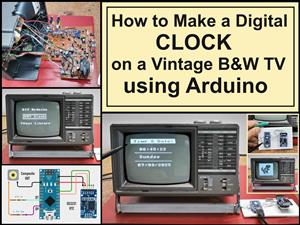 How to Make a Digital Clock on a Vintage B&W TV using Arduino
These days I accidentally came across this small retro Black and White TV with a built-in Radio, so ...
How to Make a Digital Clock on a Vintage B&W TV using Arduino
These days I accidentally came across this small retro Black and White TV with a built-in Radio, so ...
-
 Build a $10 Function Generator with Frequency Meter for Your Lab
A function generator is a piece of electronic test equipment used to generate various types of elec...
Build a $10 Function Generator with Frequency Meter for Your Lab
A function generator is a piece of electronic test equipment used to generate various types of elec...
-
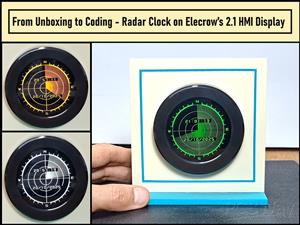 From Unboxing to Coding - Radar Clock on Elecrow’s 2.1 HMI Display
Today I received a shipment with a large round LCD display from Elecrow. The device is packed in two...
From Unboxing to Coding - Radar Clock on Elecrow’s 2.1 HMI Display
Today I received a shipment with a large round LCD display from Elecrow. The device is packed in two...
-
 Making a Retro Analog NTP Clock with Unihiker K10 - Arduino IDE Tutorial
Some time ago I presented you a way to use standard Arduino libraries on the Unihiker k10 developme...
Making a Retro Analog NTP Clock with Unihiker K10 - Arduino IDE Tutorial
Some time ago I presented you a way to use standard Arduino libraries on the Unihiker k10 developme...
-
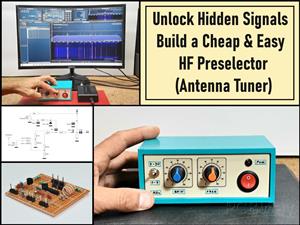 Build a Cheap & Easy HF Preselector - Antenna Tuner
HF antenna preselector is an electronic device connected between an HF radio antenna, and a radio r...
Build a Cheap & Easy HF Preselector - Antenna Tuner
HF antenna preselector is an electronic device connected between an HF radio antenna, and a radio r...
-
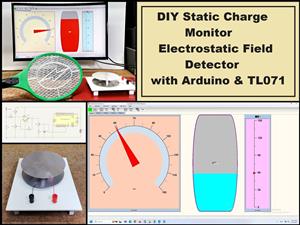 DIY Static Charge Monitor - Electrostatic Field Detector (Arduino & TL071)
A Static Charge Monitor also known as a Static Field Meter or Electrostatic Voltmeter is a device u...
DIY Static Charge Monitor - Electrostatic Field Detector (Arduino & TL071)
A Static Charge Monitor also known as a Static Field Meter or Electrostatic Voltmeter is a device u...
-
 XHDATA D-219 Radio Short Review with complete disassembly
Some time ago I received an offer from XHDATA to be one of the first test users of their new radio m...
XHDATA D-219 Radio Short Review with complete disassembly
Some time ago I received an offer from XHDATA to be one of the first test users of their new radio m...
-
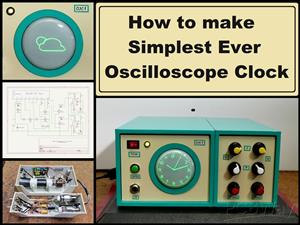 How to make Simplest ever Oscilloscope Clock
An oscilloscope clock is a unique and creative way to display the time using an oscilloscope, which...
How to make Simplest ever Oscilloscope Clock
An oscilloscope clock is a unique and creative way to display the time using an oscilloscope, which...
-
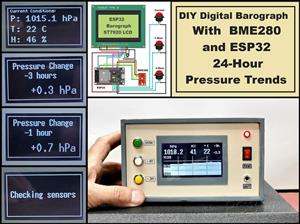 DIY Digital Barograph with BME280 and ESP32 - 24 Hour Pressure Trends
A barograph is a self-recording barometer that continuously measures and records atmospheric pressu...
DIY Digital Barograph with BME280 and ESP32 - 24 Hour Pressure Trends
A barograph is a self-recording barometer that continuously measures and records atmospheric pressu...
-
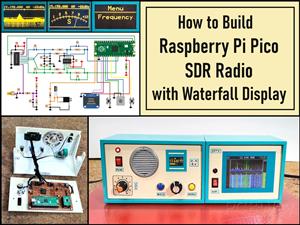 Build a Raspberry Pi Pico SDR Radio with Waterfall Display
Software-defined radio (SDR) is a radio communication system where components that have traditional...
Build a Raspberry Pi Pico SDR Radio with Waterfall Display
Software-defined radio (SDR) is a radio communication system where components that have traditional...
-
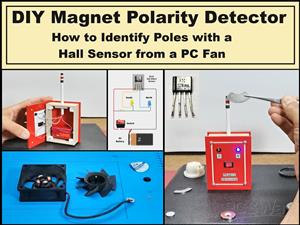 DIY Magnet Polarity Detector - How to Identify Poles with a Hall Sensor from a PC Fan
Recently, while working on a project, I needed to determine the polarity of several permanent magne...
DIY Magnet Polarity Detector - How to Identify Poles with a Hall Sensor from a PC Fan
Recently, while working on a project, I needed to determine the polarity of several permanent magne...
-
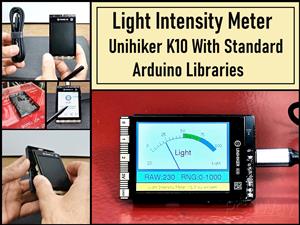 Light Meter Project - Making Dfrobot Unihiker K10 Work with Standard Arduino Libraries
The other day I received a shipment with a UNIHIKER K10 development board from DFRobot, which I rec...
Light Meter Project - Making Dfrobot Unihiker K10 Work with Standard Arduino Libraries
The other day I received a shipment with a UNIHIKER K10 development board from DFRobot, which I rec...
-
-
mammoth-3D SLM Voron Toolhead – Manual Drill & Tap Edition
140 0 0 -
-
AEL-2011 Power Supply Module
654 0 2 -
AEL-2011 50W Power Amplifier
567 0 2 -
-
-
Custom Mechanical Keyboard
769 0 0 -
Tester for Touch Screen Digitizer without using microcontroller
395 2 2 -
Audio reactive glow LED wristband/bracelet with NFC / RFID-Tags
364 0 1 -
-


















